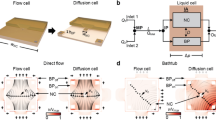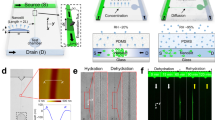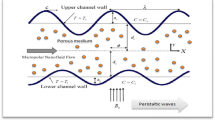Abstract
The evolution from microfluidic to nanofluidic systems has been accompanied by the emergence of new fluid phenomena and the potential for new nanofluidic devices. This review provides an introduction to the theory of nanofluidic transport, focusing on the various forces that influence the movement of both solvents and solutes through nanochannels, and reviews the applications of nanofluidic devices in separation science and energy conversion.
This is a preview of subscription content, access via your institution
Access options
Subscribe to this journal
Receive 12 print issues and online access
$259.00 per year
only $21.58 per issue
Buy this article
- Purchase on Springer Link
- Instant access to full article PDF
Prices may be subject to local taxes which are calculated during checkout






Similar content being viewed by others
References
Turner, S. W., Perez, A. M., Lopez, A. & Craighead, H. G. Monolithic nanofluid sieving structures for DNA manipulation. J. Vac. Sci. Technol. B 16, 3835–3840 (1998).
Eijkel, J. C. T. & van den Berg, A. Nanofluidics: what is it and what can we expect from it? Microfluid. Nanofluid. 1, 249–267 (2005).
Abgrall, P. & Nguyen, N. T. Nanofluidic devices and their applications. Anal. Chem. 80, 2326–2341 (2008).
Mijatovic, D., Eijkel, J. C. T. & van den Berg, A. Technologies for nanofluidic systems: top-down vs. bottom-up — a review. Lab Chip 5, 492–500 (2005).
Perry, J. L. & Kandlikar, S. G. Review of fabrication of nanochannels for single phase liquid flow. Microfluid. Nanofluid. 2, 185–193 (2006).
Schoch, R. B., Han, J. Y. & Renaud, P. Transport phenomena in nanofluidics. Rev. Mod. Phys. 80, 839–883 (2008).
Yuan, Z., Garcia, A. L., Lopez, G. P. & Petsev, D. N. Electrokinetic transport and separations in fluidic nanochannels. Electrophoresis 28, 595–610 (2007).
Succi, S., Mohammad, A. A. & Horbach, J. Lattice-Boltzmann simulation of dense nanoflows: A comparison with molecular dynamics and Navier-Stokes solutions. Int. J. Mod. Phys. C 18, 667–675 (2007).
Wijmans, J. G. & Baker, R. W. The solution-diffusion model — a review. J. Membr. Sci. 107, 1–21 (1995).
Gad-el-Hak, M. The fluid mechanics of microdevices — The Freeman scholar lecture. J. Fluid Eng.-T. ASME 121, 5–33 (1999).
Deen, W. M. Hindered transport of large molecules in liquid-filled pores. AlChE J. 33, 1409–1425 (1987).
Prieve, D. C. & Hoysan, P. M. Role of colloidal forces in hydrodynamic chromatography. J. Colloid Interf. Sci. 64, 201–213 (1978).
Ruckenstein, E. & Prieve, D. C. Adsorption and desorption of particles and their chromatographic separation. AlChE J. 22, 276–283 (1976).
Bowen, W. R. & Mukhtar, H. Characterisation and prediction of separation performance of nanofiltration membranes. J. Membr. Sci. 112, 263–274 (1996).
Lyklema, J. Fundamentals of Interface and Colloid Science, Fundamentals 1st edn (Academic Press, 2000).
Christenson, H. K. & Claesson, P. M. Direct measurements of the force between hydrophobic surfaces in water. Ad. Colloid Interf. Sci. 91, 391–436 (2001).
Meyer, E. E., Rosenberg, K. J. & Israelachvili, J. Recent progress in understanding hydrophobic interactions. Proc. Natl Acad. Sci. USA 103, 15739–15746 (2006).
Norde, W. in Physical Chemistry of Biological Interfaces (ed. Dekker, M.) 115–136 (CRC, 2000).
Giddings, J. C., Kucera, E., Russell, C. P. & Myers, M. N. Statistical theory for equilibrium distribution of rigid molecules in inert porous networks. Exclusion chromatography. J. Phys. Chem. 72, 4397–4408 (1968).
Teraoka, I. Polymer solutions in confining geometries. Prog. Polym. Sci. 21, 89–149 (1996).
Burgreen, D. & Nakache, F. R. Electrokinetic flow in ultrafine capillary slits. J. Phys. Chem. 68, 1084–1091 (1964).
Levine, S., Marriott, J. R., Neale, G. & Epstein, N. Theory of electrokinetic flow in fine cylindrical capillaries at high zeta-potentials. J. Colloid Interf. Sci. 52, 136–149 (1975).
Vinogradova, O. I. Slippage of water over hydrophobic surfaces. Int. J. Miner. Process. 56, 31–60 (1999).
Cottin-Bizonne, C., Cross, B., Steinberger, A. & Charlaix, E. Boundary slip on smooth hydrophobic surfaces: Intrinsic effects and possible artefacts. Phys. Rev. Lett. 94, 056102 (2005).
Muller, V. M., Sergeeva, I. P., Sobolev, V. D. & Churaev, N. V. Boundary effects in the theory of electrokinetic phenomena. Colloid J. USSR 48, 606–614 (1986).
Bouzigues, C. I., Tabeling, P. & Bocquet, L. Nanofluidics in the Debye layer at hydrophilic and hydrophobic surfaces. Phys. Rev. Lett. 101, 114503 (2008).
Joly, L., Ybert, C., Trizac, E. & Bocquet, L. Liquid friction on charged surfaces: From hydrodynamic slippage to electrokinetics. J. Chem. Phys. 125, 204716 (2006).
Vermesh, U. et al. Fast nonlinear ion transport via field-induced hydrodynamic slip in sub-20-nm hydrophilic nanofluidic transistors. Nano Lett. 9, 1315–1319 (2009).
Ren, Y. Q. & Stein, D. Slip-enhanced electrokinetic energy conversion in nanofluidic channels. Nanotechnology 19, 195707 (2008).
van der Heyden, F. H. J., Bonthuis, D. J., Stein, D., Meyer, C. & Dekker, C. Power generation by pressure-driven transport of ions in nanofluidic channels. Nano Lett. 7, 1022–1025 (2007).
Daiguji, H., Yang, P. D., Szeri, A. J. & Majumdar, A. Electrochemomechanical energy conversion in nanofluidic channels. Nano Lett. 4, 2315–2321 (2004).
Stein, D., van der Heyden, F. H. J., Koopmans, W. J. A. & Dekker, C. Pressure-driven transport of confined DNA polymers in fluidic channels. Proc. Natl Acad. Sci USA 103, 15853–15858 (2006).
Holt, J. K. et al. Fast mass transport through sub-2-nanometer carbon nanotubes. Science 312, 1034–1037 (2006).
Majumder, M., Chopra, N., Andrews, R. & Hinds, B. J. Nanoscale hydrodynamics: Enhanced flow in carbon nanotubes. Nature 438, 44–44 (2005).
Eijkel, J. C. T., Bomer, J. G. & van den Berg, A. Osmosis and pervaporation in polyimide submicron microfluidic channel structures. Appl. Phys. Lett. 87, 114103 (2005).
Karlsson, R. et al. Moving-wall-driven flows in nanofluidic systems. Langmuir 18, 4186–4190 (2002).
Soare, M. A., Picu, R. C., Tichy, J., Lu, T. M. & Wang, G. C. Fluid transport through nanochannels using nanoelectromechanical actuators. J. Intell. Mater. Sys. Struct. 17, 231–238 (2006).
Tas, N. R., Berenschot, J. W., Lammerink, T. S. J., Elwenspoek, M. & van den Berg, A. Nanofluidic bubble pump using surface tension directed gas injection. Anal. Chem. 74, 2224–2227 (2002).
Prieve, D. C., Anderson, J. L., Ebel, J. P. & Lowell, M. E. Motion of a particle generated by chemical gradients. 2. Electrolytes. J. Fluid Mech. 148, 247–269 (1984).
Anderson, J. L., Prieve, D. C. & Ebel, J. P. Chemically induced migration of particles across fluid streamlines. Chem. Eng. Commun. 55, 211–224 (1987).
Keh, H. J. & Wei, Y. K. Diffusioosmosis and electroosmosis of electrolyte solutions in fibrous porous media. J. Colloid Interf. Sci. 252, 354–364 (2002).
Qian, S. Z., Das, B. & Luo, X. B. Diffusioosmotic flows in slit nanochannels. J. Colloid Interf. Sci. 315, 721–730 (2007).
Ajdari, A. & Bocquet, L. Giant amplification of interfacially driven transport by hydrodynamic slip: Diffusio-osmosis and beyond. Phys. Rev. Lett. 96, 186102 (2006).
Goedecke, N., Eijkel, J. & Manz, A. Evaporation driven pumping for chromatography application. Lab Chip 2, 219–223 (2002).
Wheeler, T. D. & Stroock, A. D. The transpiration of water at negative pressures in a synthetic tree. Nature 455, 208–212 (2008).
Huh, D. et al. Tuneable elastomeric nanochannels for nanofluidic manipulation. Nature Mater. 6, 424–428 (2007).
Quake, S. R. & Scherer, A. From micro- to nanofabrication with soft materials. Science 290, 1536–1540 (2000).
Poppe, H. Some reflections on speed and efficiency of modern chromatographic methods. J. Chromatogr. A 778, 3–21 (1997).
Kievsky, Y. Y. et al. Dynamics of molecular diffusion of rhodamine 6G in silica nanochannels. J. Chem. Phys. 128, 151102 (2008).
Durand, N. F. Y., Bertsch, A., Todorova, M. & Renaud, P. Direct measurement of effective diffusion coefficients in nanochannels using steady-state dispersion effects. Appl. Phys. Lett. 91, 203106 (2007).
Karnik, R., Castelino, K., Duan, C. H. & Majumdar, A. Diffusion-limited patterning of molecules in nanofluidic channels. Nano Lett. 6, 1735–1740 (2006).
Yamaguchi, A. et al. Diffusion of metal complexes inside of silica-surfactant nanochannels within a porous alumina membrane. J. Phys. Chem. B 112, 2024–2030 (2008).
Yamaguchi, A., Yoda, T., Suzuki, S., Morita, K. & Teramae, N. Diffusivities of tris(2,2′-bipyridyl)ruthenium inside silica-nanochannels modified with alkylsilanes. Anal. Sci. 22, 1501–1507 (2006).
Schoch, R. B., Bertsch, A. & Renaud, P. pH-controlled diffusion of proteins with different pl values across a nanochannel on a chip. Nano Lett. 6, 543–547 (2006).
Crank, J. The Mathematics of Diffusion (Oxford Univ. Press, 1975).
Delamarche, E., Bernard, A., Schmid, H., Michel, B. & Biebuyck, H. Patterned delivery of immunoglobulins to surfaces using microfluidic networks. Science 276, 779–781 (1997).
Pennathur, S. & Santiago, J. G. Electrokinetic transport in nanochannels. 1. Theory. Anal. Chem. 77, 6772–6781 (2005).
Pennathur, S. & Santiago, J. G. Electrokinetic transport in nanochannels. 2. Experiments. Anal. Chem. 77, 6782–6789 (2005).
Pennathur, S. et al. Free-solution oligonucleotide separation in nanoscale channels. Anal. Chem. 79, 8316–8322 (2007).
Xuan, X. C. Ion separation in nanofluidics. Electrophoresis 29, 3737–3743 (2008).
Wang, X. Y., Kang, J. Z., Wang, S. L., Lu, J. J. & Liu, S. R. Chromatographic separations in a nanocapillary under pressure-driven conditions. J. Chromatogr. A 1200, 108–113 (2008).
Ogston, A. G. The spaces in a uniform random suspension of fibres. Trans. Faraday Soc. 54, 1754–1757 (1958).
Fu, J. P., Schoch, R. B., Stevens, A. L., Tannenbaum, S. R. & Han, J. Y. A patterned anisotropic nanofluidic sieving structure for continuous-flow separation of DNA and proteins. Nature Nanotech. 2, 121–128 (2007).
Blom, M. T., Chmela, E., Oosterbroek, R. E., Tijssen, R. & van den Berg, A. On-chip hydrodynamic chromatography separation and detection of nanoparticles and biomolecules. Anal. Chem. 75, 6761–6768 (2003).
Stein, D., van der Heyden, F. H. J., Koopmans, W. J. A. & Dekker, C. Pressure driven transport iof confined DNA polymers in fluidic channels. Proc. Natl Acad. Sci. USA 103, 15853–15858 (2006).
Han, J. & Craighead, H. G. Separation of long DNA molecules in a microfabricated entropic trap array. Science 288, 1026–1029 (2000).
Li, Z. R. et al. Continuum transport model of Ogston sieving in patterned nanofilter arrays for separation of rod-like biomolecules. Electrophoresis 29, 329–339 (2008).
Turner, S. W. P., Cabodi, M. & Craighead, H. G. Confinement-induced entropic recoil of single DNA molecules in a nanofluidic structure. Phys. Rev. Lett. 88, 128103 (2002).
Austin, R. Nanofluidics: A fork in the nano-road. Nature Nanotech. 2, 79–80 (2007).
Tegenfeldt, J. O. et al. Micro- and nanofluidics for DNA analysis. Anal. Bioanal. Chem. 378, 1678–1692 (2004).
Mannion, J. T., Reccius, C. H., Cross, J. D. & Craighead, H. G. Conformational analysis of single DNA molecules undergoing entropically induced motion in nanochannels. Biophys. J. 90, 4538–4545 (2006).
Cross, J. D., Strychalski, E. A. & Craighead, H. G. Size-dependent DNA mobility in nanochannels. J. Appl. Phys. 102, 024514 (2007).
Salieb-Beugelaar, G. B. et al. Field-dependent DNA mobility in 20 nm high nanoslits. Nano Lett. 8, 1785–1790 (2008).
Kuo, T. C., Sloan, L. A., Sweedler, J. V. & Bohn, P. W. Manipulating molecular transport through nanoporous membranes by control of electrokinetic flow: Effect of surface charge density and Debye length. Langmuir 17, 6298–6303 (2001).
Karnik, R., Castelino, K. & Majumdar, A. Field-effect control of protein transport in a nanofluidic transistor circuit. Appl. Phys. Lett. 88, 123114 (2006).
Miedema, H. et al. A biological porin engineered into a molecular, nanofluidic diode. Nano Lett. 7, 2886–2891 (2007).
Garcia-Gimenez, E., Alcaraz, A., Aguilella, V. M. & Ramirez, P. Directional ion selectivity in a biological nanopore with bipolar structure. J. Membr. Sci. 331, 137–142 (2009).
Ali, M., Ramirez, P., Mafe, S., Neumann, R. & Ensinger, W. A pH-tunable nanofluidic diode with a broad range of rectifying properties. ACS Nano 3, 603–608 (2009).
Karnik, R., Duan, C. H., Castelino, K., Daiguji, H. & Majumdar, A. Rectification of ionic current in a nanofluidic diode. Nano Lett. 7, 547–551 (2007).
Alcaraz, A. et al. A pH-tunable nanofluidic diode: Electrochemical rectification in a reconstituted single ion channel. J. Phys. Chem. B 110, 21205–21209 (2006).
Cheng, L. J. & Guo, L. J. Rectified ion transport through concentration gradient in homogeneous silica nanochannels. Nano Lett. 7, 3165–3171 (2007).
Fan, R., Huh, S., Yan, R., Arnold, J. & Yang, P. D. Gated proton transport in aligned mesoporous silica films. Nature Mater. 7, 303–307 (2008).
Fan, R., Yue, M., Karnik, R., Majumdar, A. & Yang, P. D. Polarity switching and transient responses in single nanotube nanofluidic transistors. Phys. Rev. Lett. 95, 086607 (2005).
Karnik, R. et al. Electrostatic control of ions and molecules in nanofluidic transistors. Nano Lett. 5, 943–948 (2005).
Kuo, T. C. et al. Gateable nanofluidic interconnects for multilayered microfluidic separation systems. Anal. Chem. 75, 1861–1867 (2003).
Vlassiouk, I. & Siwy, Z. S. Nanofluidic diode. Nano Lett. 7, 552–556 (2007).
Gijs, M. A. M. Device physics: Will fluidic electronics take off? Nature Nanotech. 2, 268–270 (2007).
Pu, Q. S., Yun, J. S., Temkin, H. & Liu, S. R. Ion-enrichment and ion-depletion effect of nanochannel structures. Nano Lett. 4, 1099–1103 (2004).
Wang, Y. C., Stevens, A. L. & Han, J. Y. Million-fold preconcentration of proteins and peptides by nanofluidic filter. Anal. Chem. 77, 4293–4299 (2005).
Mani, A., Zangle, T. A. & Santiago, J. G. On the propagation of concentration polarization from microchannel-nanochannel interfaces part I: Analytical model and characteristic analysis. Langmuir 25, 3898–3908 (2009).
Zangle, T. A., Mani, A. & Santiago, J. G. On the propagation of concentration polarization from microchannel-nanochannel interfaces part II: Numerical and experimental study. Langmuir 25, 3909–3916 (2009).
Plecis, A., Nanteuil, C., Haghiri-Gosnet, A. M. & Chen, Y. Electropreconcentration with charge-selective nanochannels. Anal. Chem. 80, 9542–9550 (2008).
Han, A. P., de Rooij, N. F. & Staufer, U. Design and fabrication of nanofluidic devices by surface micromachining. Nanotechnology 17, 2498–2503 (2006).
Han, J. Y., Fu, J. P. & Schoch, R. B. Molecular sieving using nanofilters: Past, present and future. Lab Chip 8, 23–33 (2008).
Eijkel, J. C. T. Scaling revisited. Lab Chip 7, 1630–1632 (2007).
Osterle, J. F. Unified treatment of thermodynamics of steady-state energy conversion. Appl. Sci. Res. A 12, 425–434 (1964).
Burgreen, D. & Nakache, F. R. Efficiency of pumping and power generation in ultrafine electrokinetic systems J. Appl. Mech. 32, 675–679 (1965).
Davidson, C. & Xuan, X. C. Electrokinetic energy conversion in slip nanochannels. J. Power Sources 179, 297–300 (2008).
Davidson, C. & Xuan, X. C. Effects of Stern layer conductance on electrokinetic energy conversion in nanofluidic channels. Electrophoresis 29, 1125–1130 (2008).
Pennathur, S., Eijkel, J. C. T. & van den Berg, A. Energy conversion in microsystems: is there a role for micro/nanofluidics? Lab Chip 7, 1234–1237 (2007).
Probstein, R. F. Physicochemical Hydrodynamics: An Introduction 2nd edn (Wiley, 1994).
van Oss, C. J. Long-range and short-range mechanisms of hydrophobic attraction and hydrophilic repulsion in specific and aspecific interactions. J. Mol. Recogn. 16, 177–190 (2003).
Ninham, B. W. & Yaminsky, V. Ion binding and ion specificity: The Hofmeister effect and Onsager and Lifshitz theories. Langmuir 13, 2097–2108 (1997).
Pierret, R. F. Semiconductor Device Fundamentals (Addison-Wesley, 1996).
Acknowledgements
We thank the Dutch Technology Foundation (STW) for financial support via a NanoNed grant (TMM 7128).
Author information
Authors and Affiliations
Corresponding author
Rights and permissions
About this article
Cite this article
Sparreboom, W., van den Berg, A. & Eijkel, J. Principles and applications of nanofluidic transport. Nature Nanotech 4, 713–720 (2009). https://doi.org/10.1038/nnano.2009.332
Published:
Issue Date:
DOI: https://doi.org/10.1038/nnano.2009.332
This article is cited by
-
Electrokinetic manipulation of a nanowire
Nature Nanotechnology (2023)
-
Photosensitive ion channels in layered MXene membranes modified with plasmonic gold nanostars and cellulose nanofibers
Nature Communications (2023)
-
Carbon nanofibers membrane bridged with graphene nanosheet and hyperbranched polymer for high-performance osmotic energy harvesting
Nano Research (2023)
-
Bionic iontronics based on nano-confined structures
Nano Research (2023)
-
3D-printed mechanically strong and extreme environment adaptable boron nitride/cellulose nanofluidic macrofibers
Nano Research (2023)



